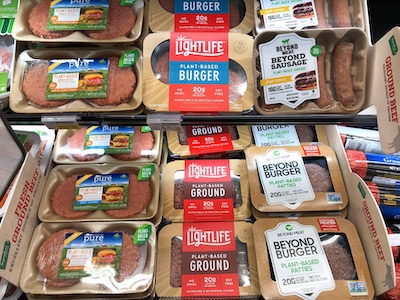Note: This blog was written jointly by Marianne Smith Edge and Jennifer Garrett based on their recent article, “The Nutritional Limitations of Mimicking Meat” published in the July/August 2020 issue of Cereal Foods World.
Quick, what is the first word that comes to your mind when you hear “plant”? What images or phases pop into your mind? Do you think of fruits and vegetables, fresh produce, heart health or clean eating? The connection of health and plants go back thousands of years to the beginning of humanity as most of our medicines were from plants.1 Perhaps, it is from this long-standing positive health association with plants that “meatless meat” or “dairy-free milk” labels have evolved to being labeled as plant-based meat and milk. So, for consumers who have a desire to eat healthier, seeking plant-based meats may seem to be a natural fit to support a healthy choice. But, is this a “healthy” choice or simply a “health halo”?
What’s Beneath the Health “Halo”?

Sometimes as consumers, we get so excited about ”‘new” choices like plant-based burgers that promote our perception of “healthy” and culinary curiosity that we overlook the nutritional benefits of existing choices like lean ground beef. So, let’s dive deeper into one of the more popular nutrients for discussion — protein.
Protein Quantity vs. Quality
A quick review of plant-based burgers reflect that most contain approximately 20 grams of protein or the equivalent to a three-ounce serving of meat. However, not all proteins are created equal! Some health experts say that protein quality is not an issue because as, a society, we consume more than is recommended and protein is in almost everything. Both lines of thought have some legitimacy, but like my goal to make my “calories count” when enjoying a dessert, the same applies to protein. So, let’s review the basic facts:
- Protein quality is determined by its amino acid composition and digestibility.
- Proteins with the highest number of the nine essential amino acids (EAA) and bioavailability will be the most useful to the body.
- EAAs are not made by the body, so they must be supplied through the food and beverages we eat and drink.
- Digestible EAAs are required for vital functions in our bodies such as making protein, tissue repair, muscle development and nutrient absorption.
Meat, poultry, eggs, dairy and fish contain all nine essential amino acids. Soy also contains all nine essential amino acids but in lower quantities and digestibility than animal and fish sources. Other than soy, no other common vegetable-based protein contains all the essential amino acids. In turn, we need multiple sources of the right “incomplete proteins” to provide the best combination of digestible EAAs.

Beyond Protein
As with any food, there is more than a single nutrient that determines nutritional content, and meat and meat alternatives are no exception. Animal and fish sources naturally provide a nutrient dense bundle of vitamins and minerals, especially niacin, thiamine, Vitamins B6 and B12, zinc, chloride and selenium. Since many of these vitamins and minerals aren’t inherent to plants to the degree they are in animal sources, food manufacturers add them to the plant-based burger to rival the bundle in animal-based burgers. A recent International Food Information Council (IFIC) consumer research study found that consumers were more likely to identify an unnamed product more healthful based on the longer list of vitamin and minerals on a Nutrition Fact Panel.3 Food manufacturers are legally required to list only iron, potassium and calcium on the Nutrition Fact Panel label. So, the complete vitamin and mineral package may be a hidden message for naturally occurring foods like animal-based meats if relying only on the food label.
It’s Still About Consumer Choice
With the advancement of food science and food technology, the choices we have at the retail level are limited only by our taste preferences and budgets. If the recent announcements of more plant-based options in grocery stores4, 5 and the continued investment by “new age meat” companies to develop more plant-based options are any indication, the choices for consumers will only grow … along with the confusion. Based on the nutritional profile comparison of plant-based and beef burgers in our published article, the 93% lean beef burger choice has the nutrient advantage in all categories. However, with current pandemic concerns of food supply and safety and sustainability, the “health halo” for plant-based meats may extend beyond nutritional content and personal health. The choice of what to buy lies within each of us and our respective value system. For many, animal protein will always be a staple in their diets. For others, it will be limited or none at all. The most important thing is to know what you are buying and get the perceived value you want.6
References:
1. “How Did We Get to the Term ‘Plant-Based?’ The Role of Plants in Our Diets, Language and Culture,” The Hartman Group Newsletter, November 12, 2019.
2. “The Nutrition Limitations of Mimicking Meat,” Marianne Smith Edge and Jennifer Garrett, Cereal Foods World, Vol. 65, Number 4, July/August 2020.
3. “Consumer Survey on Plant Alternatives to Animal Meat,” International Food Information Council Foundation, Washington, D.C., December 2019 and March 2020.
4. “Beyond Meat to sell plant-based sausage patties in 5,000 more US stores,” New York Post, September 21, 2020. Accessed October 6, 2020.
5. “Beyond Meat plans to triple distribution at Walmart amid growing demand,” New York Post, September 29, 2020. Accessed October 6, 2020.
6. “What’s Driving the Trend of Plant-Based Burgers? Personal or Planet Health?” Meet Me at the Table Blog, Marianne Smith Edge, July 11, 2019.

